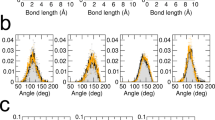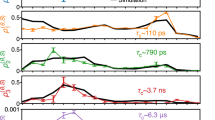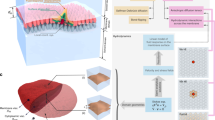Abstract
Numerical simulation is often a useful tool f or investigating the behaviour of complex systems with many degrees of freedom. Of the two major methods in this field, the Monte Carlo method and the molecular dynamics method, only the first has been applied to realistic models of lipid monolayers1–5. The term lipid monolayer is used here to describe a class of systems consisting of chain molecules on a liquid substrate, the characteristic properties of which can be summarized as follows. (1) The constituent molecules are amphipathic, that is they consist of a hydrophilic (polar) head group and one or more hydrophobic hydrocarbon chains. (2) Due to the amphipathic character of the molecules, the head groups are constrained to the plane of the substrate, whereas the tails are directed outwards from this plane. (3) The collective properties of the molecules are determined by their short-range repulsive and long-range attractive interactions and by the steric repulsion of the tails. We now present what we believe to be the first molecular dynamics simulation of a realistic model of a lipid monolayer. The model system, which has all three properties enumerated above, shows a first order phase transition from an ordered fluid-like state to a disordered, gas-like state.
This is a preview of subscription content, access via your institution
Access options
Subscribe to this journal
Receive 51 print issues and online access
$199.00 per year
only $3.90 per issue
Buy this article
- Purchase on Springer Link
- Instant access to full article PDF
Prices may be subject to local taxes which are calculated during checkout
Similar content being viewed by others
References
Whitttington, S. G. & Chapman, D. Trans. Faraday Soc. 62, 3319–3324 (1966).
Scott, H. L. Biochim. biophys. Acta 469, 264–271 (1977).
Belle, J. & Bothorel, P. Biochem.biophys. Res. Commun. 58, 433–436 (1974).
Bothorel, P., Belle, J. & Lemaire, B. Chem. Phys. Lipids 12, 96–116 (1974).
Marcelja, S. J. chem. Phys. 60, 3599–3604 (1974); Biochim. biophys. Ada 367, 165–176 (1974); Biochim. biophys. Acta 455, 1–7 (1976).
Cotterill, R. M. J. Biochim. biophys. Acta 433, 264–270 (1976).
Toxvaerd, S. J. chem. Phys. 67, 2056–2060 (1977).
Wiegel, F. W. & Kox, A. J. Adv. chem. Phys. 41, 195–228 (1980).
Verlet, L. Phys. Rev. 159, 98–103 (1967).
Michels, J. P. J. Physica 90A, 179–195 (1978).
Hoover, W. G. & Alder, B. J. J. chem. Phys. 46, 686–691 (1967).
Wiegel, F. W. J. Stat. Phys. 13, 515–530 (1975).
Wiegel, F. W. Phys. Lett. 57A, 393–394 (1976).
Wiegel, F. W. Physica 89A, 397–407 (1977).
Author information
Authors and Affiliations
Rights and permissions
About this article
Cite this article
Kox, A., Michels, J. & Wiegel, F. Simulation of a lipid monolayer using molecular dynamics. Nature 287, 317–319 (1980). https://doi.org/10.1038/287317a0
Received:
Accepted:
Published:
Issue Date:
DOI: https://doi.org/10.1038/287317a0
This article is cited by
Comments
By submitting a comment you agree to abide by our Terms and Community Guidelines. If you find something abusive or that does not comply with our terms or guidelines please flag it as inappropriate.



